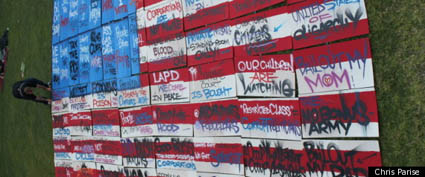Saber, Graffiti Artist, Fights To Lift Mural Ban In LA
by Andrew Reilly
Huffington Post
October 14, 2011

For the artist Saber, participation in the democratic process has always been complicated. He’s an international graffiti legend, holding the world record for the largest graffiti piece, done along the LA river in 1997. Despite its place in the history books, the city of Los Angeles spent a whopping $837,000 to paint over it in 2009. Now Saber is approaching public art laws from a different angle, spearheading an effort to reform Los Angeles’ mural policies.
At the moment, LA’s regulations don’t begin to reflect the city’s vibrant public art culture; uncommissioned murals are banned outright, even if the mural is painted on private property with the consent of the owner. Violators are subject to serious punishment, as was the case with prominent LA artist Revok, who received 180 days jail time over various vandalism charges.
To address the ongoing issues of the mural moratorium, Tanner Blackman, of the Department of City Planning Code Studies Section, presented a report before the joint City Council committee on October 12.
 At the meeting, Saber spoke out amid a sea of supporters to bring attention to what he called the “uglier” side of the mural moratorium.
At the meeting, Saber spoke out amid a sea of supporters to bring attention to what he called the “uglier” side of the mural moratorium.
“Right now I have a best friend who was charged with a felony because he’s on probation for painting a mural and they want to put up a civil case against him for over $150,000 for painting murals … this is all money being allocated for the sheriffs to run around, basically rampant, and do what they want and target certain people.”
Tension between LAPD and graffiti artists has worsened since Los Angeles museums began accepting street art and graffiti as legitimate art forms. The “Art In The Streets” exhibit at MOCA drew criticism from LAPD for indirectly encouraging vandalism and other illegal activity in the surrounding neighborhood.
Among other concerns raised at the meeting was the fact that the city of Los Angeles spends about $7 million annually to remove graffiti, and the Department of Cultural Affairs’ 2011 Report on Fine Art Murals says graffiti abatement in general costs the city about $70 million annually. Opponents of the policies, including Saber, believe the money could be put to better use. “In this time of economic hardship,” the artist remarked, “the city’s tax dollars could be used differently. Currently, resources are used by law officials to threaten, harass, and fine building owners … I think this current situation sucks.”
Rather than lie in wait as politicians decide the fate of LA’s mural culture, Saber decided to get involved and started his own petition against the current mural moratorium, which he presented at the meeting. As of October 13, the petition included over 6,000 signatures and Saber says it’s “still growing.”
According to Blackman’s presentation, Los Angeles allows murals on city, state and federal property, but these avenues involve layers of bureaucracy that may discourage the spontaneous production of art. Murals on private property are banned unless they are approved on a case-by-case basis; no general policy is in place. Murals are lumped in with commercial signage and advertisements, one classification that the proposed reforms would eliminate.
This makes it difficult for private property owners to gain approval for site-specific murals and many simply circumvent the complicated process, risking hefty fines. Not only that, but as they are defined by law, “mural signs” are not allowed to include more than 3% text, inevitably making a mural done in the style of graffiti illegal. This stipulation stems from concerns that mural signage could be abused for advertising purposes, but it also provides a convenient way to bar graffiti or any other text-based form of art from ever being included.
Blackman proposed three approaches to end the mural moratorium.
One method, known as the “easement approach,” would see the city enter into an agreement with private property owners. Murals could be sanctioned after public approval and the city would commit to maintaining the mural for five years, given that they fall under certain regulations.
However, this approach has been met with some criticism after it was implemented in Portland, Oregon. Saber echoes these sentiments, saying, “I want building owners who agree to have an artist paint their walls to have to deal with as little bureaucracy as possible, so nothing stands in the way of them wanting art on their property.”
The other approaches involve murals being redefined as separate from signage and approved on a case-by-case basis or setting up “mural districts” which would allow each district to approve murals as they see fit. Despite the optimistic tone of community involvement, Saber is skeptical of such an approach, remarking, “I don’t like the idea of needing community approval for artwork on private buildings. Art is subjective; as long as it’s not vulgar, it’s only up to the artist and the building owner.” Regarding this challenge for the creation of future murals, Blackman noted that works could only be limited by “time/place/manner” restrictions and approval would have to be “content neutral.”
Regardless of his reservations, Saber feels that this is a move in the right direction. “I have faith in Tanner Blackman from LA City and Planning, as well as Councilman Ed Reyes for tackling this issue. With the public’s support behind it, Los Angeles may one day reclaim the title as the ‘mural capital of the world.'”
photos: Chris Parise
